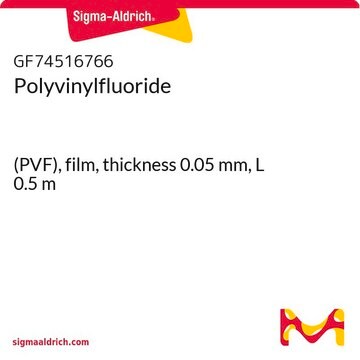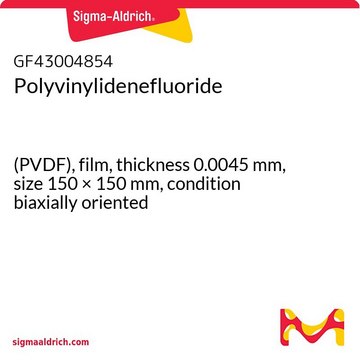427152
Poly(vinylidene fluoride)
average Mw ~180,000 by GPC, average Mn ~71,000, beads or pellets
Synonym(s):
PVDF
About This Item
Recommended Products
vapor pressure
15 mmHg ( 32 °C)
form
beads or pellets
melt index
20-35 g/10 min (230°C/3.8kg)
mol wt
average Mn ~71,000
average Mw ~180,000 by GPC
impact strength
2-4 ft-lb/in. (Izod, ASTM D 256, notched)
dielectric constant
8.0-9.5, 100 Hz (ASTM D 150)
hardness
76-80 (Shore D, ASTM D 2240)
refractive index
n20/D 1.42
ASTM D 3835
6,000-7,500 poise(230 °C) (100 sec-1)(lit.)
transition temp
brittleness temperature -62 °C (ASTM D 746)
Tm 155-165 °C
solubility
some polar solvents such as organic esters and amines: soluble
density
1.78 g/mL at 25 °C
SMILES string
FC(F)=C
InChI
1S/C2H2F2/c1-2(3)4/h1H2
InChI key
BQCIDUSAKPWEOX-UHFFFAOYSA-N
Looking for similar products? Visit Product Comparison Guide
Application
Features and Benefits
Storage Class
11 - Combustible Solids
wgk_germany
WGK 3
flash_point_f
Not applicable
flash_point_c
Not applicable
ppe
Eyeshields, Gloves, type N95 (US)
Certificates of Analysis (COA)
Search for Certificates of Analysis (COA) by entering the products Lot/Batch Number. Lot and Batch Numbers can be found on a product’s label following the words ‘Lot’ or ‘Batch’.
Already Own This Product?
Find documentation for the products that you have recently purchased in the Document Library.
Customers Also Viewed
Articles
In this article, we discuss issues critical to successful application of the electrospinning technique, including control of individual nanofibers to form secondary structures and assembly of nanofibers into 3D architectures.
Our team of scientists has experience in all areas of research including Life Science, Material Science, Chemical Synthesis, Chromatography, Analytical and many others.
Contact Technical Service








